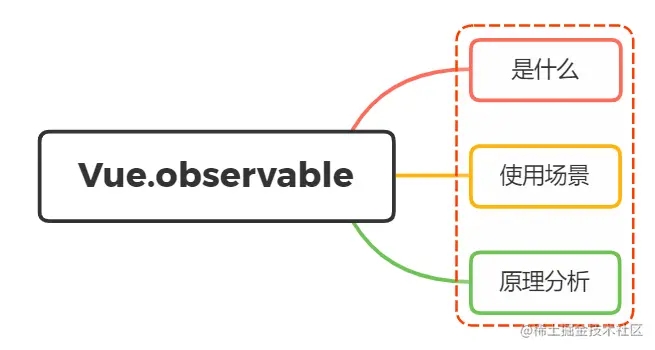Vue面试中observable原理详解
目录
- 一、Observable 是什么
- 二、使用场景
- 三、原理分析
一、Observable 是什么

Observable 翻译过来我们可以理解成可观察的
我们先来看一下其在Vue中的定义
Vue.observable,让一个对象变成响应式数据。Vue 内部会用它来处理 data 函数返回的对象
返回的对象可以直接用于渲染函数和计算属性内,并且会在发生变更时触发相应的更新。也可以作为最小化的跨组件状态存储器
Vue.observable({ count : 1})
其作用等同于
new vue({ count : 1})
在 Vue 2.x 中,被传入的对象会直接被 Vue.observable 变更,它和被返回的对象是同一个对象
在 Vue 3.x 中,则会返回一个可响应的代理,而对源对象直接进行变更仍然是不可响应的
二、使用场景
在非父子组件通信时,可以使用通常的bus或者使用vuex,但是实现的功能不是太复杂,而使用上面两个又有点繁琐。这时,observable就是一个很好的选择
创建一个js文件
// 引入vue
import Vue from 'vue
// 创建state对象,使用observable让state对象可响应
export let state = Vue.observable({
name: '张三',
'age': 38
})
// 创建对应的方法
export let mutations = {
changeName(name) {
state.name = name
},
setAge(age) {
state.age = age
}
}
在.vue文件中直接使用即可
<template>
<div>
姓名:{{ name }}
年龄:{{ age }}
<button @click="changeName('李四')">改变姓名</button>
<button @click="setAge(18)">改变年龄</button>
</div>
</template>
import { state, mutations } from '@/store
export default {
// 在计算属性中拿到值
computed: {
name() {
return state.name
},
age() {
return state.age
}
},
// 调用mutations里面的方法,更新数据
methods: {
changeName: mutations.changeName,
setAge: mutations.setAge
}
}
三、原理分析
源码位置:src\core\observer\index.js
export function observe (value: any, asRootData: ?boolean): Observer | void {
if (!isObject(value) || value instanceof VNode) {
return
}
let ob: Observer | void
// 判断是否存在__ob__响应式属性
if (hasOwn(value, '__ob__') && value.__ob__ instanceof Observer) {
ob = value.__ob__
} else if (
shouldObserve &&
!isServerRendering() &&
(Array.isArray(value) || isPlainObject(value)) &&
Object.isExtensible(value) &&
!value._isVue
) {
// 实例化Observer响应式对象
ob = new Observer(value)
}
if (asRootData && ob) {
ob.vmCount++
}
return ob
}
Observer类
export class Observer {
value: any;
dep: Dep;
vmCount: number; // number of vms that have this object as root $data
constructor (value: any) {
this.value = value
this.dep = new Dep()
this.vmCount = 0
def(value, '__ob__', this)
if (Array.isArray(value)) {
if (hasProto) {
protoAugment(value, arrayMethods)
} else {
copyAugment(value, arrayMethods, arrayKeys)
}
this.observeArray(value)
} else {
// 实例化对象是一个对象,进入walk方法
this.walk(value)
}
}
walk函数
walk (obj: Object) {
const keys = Object.keys(obj)
// 遍历key,通过defineReactive创建响应式对象
for (let i = 0; i < keys.length; i++) {
defineReactive(obj, keys[i])
}
}
defineReactive方法
export function defineReactive (
obj: Object,
key: string,
val: any,
customSetter?: ?Function,
shallow?: boolean
) {
const dep = new Dep()
const property = Object.getOwnPropertyDescriptor(obj, key)
if (property && property.configurable === false) {
return
}
// cater for pre-defined getter/setters
const getter = property && property.get
const setter = property && property.set
if ((!getter || setter) && arguments.length === 2) {
val = obj[key]
}
let childOb = !shallow && observe(val)
// 接下来调用Object.defineProperty()给对象定义响应式属性
Object.defineProperty(obj, key, {
enumerable: true,
configurable: true,
get: function reactiveGetter () {
const value = getter ? getter.call(obj) : val
if (Dep.target) {
dep.depend()
if (childOb) {
childOb.dep.depend()
if (Array.isArray(value)) {
dependArray(value)
}
}
}
return value
},
set: function reactiveSetter (newVal) {
const value = getter ? getter.call(obj) : val
/* eslint-disable no-self-compare */
if (newVal === value || (newVal !== newVal && value !== value)) {
return
}
/* eslint-enable no-self-compare */
if (process.env.NODE_ENV !== 'production' && customSetter) {
customSetter()
}
// #7981: for accessor properties without setter
if (getter && !setter) return
if (setter) {
setter.call(obj, newVal)
} else {
val = newVal
}
childOb = !shallow && observe(newVal)
// 对观察者watchers进行通知,state就成了全局响应式对象
dep.notify()
}
})
}
以上就是Vue面试中observable原理详解的详细内容,更多关于Vue observable原理的资料请关注我们其它相关文章!
赞 (0)

